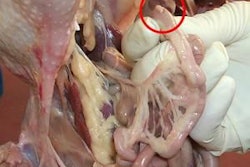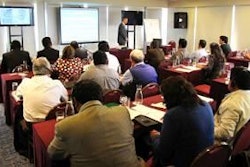It is often difficult to determine how Salmonella issues in poultry begin and what measures should be implemented to prevent them. Chickens may become colonized through both vertical (from parent stock) and horizontal (environmental) means. This article describes how Salmonella colonizes poultry and explains effective measures for preventing or controlling it.
Breeder chicken origin
Many scientists have implicated breeder chickens as vehicles for vertical transmission of Salmonella to the fertile egg.
In 1991, Cox and other researchers evaluated egg fragments, paper pads from chick boxes, and chick fluff from six commercial broiler breeder hatcheries for the presence and level of salmonellae. Overall, 42 of 380 samples (11.1%) from the six hatcheries were contaminated with salmonellae. Salmonella was detected in 22 of 145 (15.2%), five of 100 (4.6%), and 15 of 125 (12%) samples of egg fragments, chick fluff, and paper pads, respectively.
The researchers found the incidence and extent of salmonellae-positive samples in the breeder hatcheries were much less than that previously found in broiler hatcheries, meaning that overall, the industry is reducing Salmonella in breeder chicken populations. They concluded that the cycle of salmonellae contamination will not likely be broken until contamination at these critical points is eliminated.
Research also has shown that breeders infected with salmonellae may not always be easily detectable on the farm because egg production rate for infected chickens may be unaffected and Salmonella may not be detected in fecal samples.
Furthermore, Bailey and fellow researchers, in 2002, concluded that there was poor correlation between the Salmonella serotypes found in breeder farms and those found in the hatchery.
Although the widespread presence of Salmonella in all phases of broiler chicken production and processing is well documented, little information is available to indicate the identity and movement of specific serotypes of Salmonella through the different phases of an integrated operation.
Semen implicated
Studies have been conducted to determine how vertical transmission from the breeder to the baby broiler chick occurs. In 1995 Reiber et al. conducted three experiments to determine the bacteriological quality of rooster semen. The most frequently isolated genera of bacteria from rooster semen included Escherichia, Staphylococcus, Micrococcus, Enterococcus, and Salmonella. Most of the bacteria that were isolated were endemic to poultry and were commonly found in the environment of chickens (Reiber et al., 1995). Thus, during mating, female breeders may become inoculated with Salmonella during semen transmission.
Buhr et al. (2005) reported the recovery of Campylobacter (naturally colonized) from the ductus deferens of 5 of 101 broiler breeder roosters, and four of those five positive roosters had previously produced Campylobacter-positive semen samples. Those results prompted further evaluation to determine if inoculation route influenced the prevalence or level of Campylobacter contamination of semen, the digestive tract, or reproductive organs. Individually caged roosters, confirmed to be feces and semen negative for Campylobacter, were challenged with a marker strain of Campylobacter jejuni either orally, by placing Campylobacter onto the everted phallus immediately after semen collection, or by dip coating an ultrasound probe in Campylobacter and inserting the probe through the vent into the colon. Six days after inoculation, individual feces and semen samples were again collected and cultured for Campylobacter.
Seven days postinoculation, roosters were killed, the abdomen aseptically opened to expose the viscera, and one cecum, one testis, and both ductus deferens were collected. Campylobacter was recovered 6 days after challenge from feces in 82% of samples (log104.1 colony-forming units [CFU]/g sample), 85% of semen samples (log102.9 CFU/ml), and on the seventh day after challenge from 88% of cecal samples (log105.8 CFU/g sample). These results demonstrate that male breeders exposed to Salmonella and Campylobacter may pass these bacteria on to the female during mating. This helps to explain how vertical transmission with these pathogens occurs.
Effect of disinfection and rodents
In a study to determine the effect of disinfection on Salmonella in breeders, three broiler breeder houses at three different locations were sampled before and after cleansing and disinfection (Davies and Wray, 1996). None of the farms were able to achieve total elimination of Salmonella Enteritidis from the poultry house environment. The authors concluded that, in each of the three breeder houses, failure to eliminate mice from the house that was infected with S. Enteritidis was likely to be the most important hazard for transmission to the next flock (Davies and Wray, 1996).
These studies demonstrate that both vertical and horizontal transmission of Salmonella from breeders and from the environment may occur. Any potential intervention at this stage of production must focus on controlling Salmonella in breeders and in the environment of the breeder chickens.
Interventions for breeders
Over the years, a number of methods have been used to eliminate Salmonella from breeder chicken populations. One method employed in Denmark, Sweden, and the Netherlands is to test breeder flocks and, if found to be positive for Salmonella, slaughter them.
Slaughtering positive flocks
Rapid increases in the incidence in human salmonellosis in the second half of the 1980s in Denmark was attributed to the spread of Salmonella in broiler chickens. Because of this link to poultry, a targeted national control program was initiated. Initially, the aim of the program was to reduce Salmonella in broiler flocks to less than 5% prevalence (Wegener et al., 2003). The program was developed based on the concept of eliminating Salmonella from the breeders, which will then theoretically ensure that broilers and processed products would be free from Salmonella. Wegener et al. (2003) reported that infected flocks of breeder chickens are destroyed, and infected birds are slaughtered. The intensive testing program developed gradually over time. Birds from Salmonella-positive flocks are slaughtered on separate slaughter lines or late in the day to avoid cross-contamination of Salmonella-negative birds. One incentive the Danes give poultry growers is that farmers get a better price for birds from Salmonella-free flocks, and slaughterhouses can use the label “Salmonella-free” for birds that meet criteria determined by the authorities (Wegener et al., 2003). The effect of this program may be seen in Figure 1.
However, it is important to note that due to the sheer size of the poultry industry in the U.S., this approach would be impossible. For example, roughly twice as much poultry was produced in Athens, Ga., last year than produced in all of Sweden. When we compare the rate of human salmonellosis between Sweden and the U.S. we find 42.8 per 100,000 people in Sweden versus the U.S. where it is 14.9 per 100,000 people. The question is, “In a country where extraordinarily expensive measures are used to eliminate Salmonella from the flocks prior to processing, what are they getting for their money?”
Medications and competitive exclusion
Scientists have been working for decades in an attempt to control Salmonella colonization of chickens using bacterial cultures that will colonize the baby chick and thus, prevent Salmonella from colonizing the chick. Another approach has been to use antibiotics to prevent colonization of the chickens with Salmonella. In 1997, Reynolds et al. medicated breeding flocks of domestic fowl (Gallus gallus) using an antimicrobial treatment followed by competitive exclusion in 13 trials between February and September 1993. This approach was being used as an alternative to the Swedish model such that positive flocks would not have to be slaughtered, but would be treated instead. In each trial, the flock had been confirmed as naturally infected with Salmonella enterica serovar Enteritidis and the effect of treatment was determined on Salmonella isolation from internal tissues.
Of the 11 trials where enrofloxacin was used to medicate the flocks, a long-term reduction of Salmonella was observed in two and a short-term reduction was measured in birds from another five trials. Salmonella Enteritidis was isolated from birds after treatment in four other trials with enrofloxacin and in two trials of medication with amoxycillin. The authors of this study concluded that enrofloxacin significantly reduced the prevalence of S. Enteritidis in tissues from birds, and reduced the level and prevalence of Salmonella in the bird’s environment. No Salmonella was identified in statutory meconium samples taken from the hatched chicks derived from the flocks after treatment. The program of antibiotic treatment and competitive exclusion offers an alternative to slaughter, but the approach must be part of a coordinated program, which will effect a decrease in the prevalence of S. Enteritidis over time by contemporary use of disease security measures (Reynolds et al., 1997). This approach in the U.S. may not be acceptable as many companies are trying to decrease the use of prophylactic antibiotics in order to preclude development of antibiotic resistant bacteria.
Vaccination
A number of poultry companies have investigated the use of vaccines for eliminating Salmonella in breeder flocks. Inoue et al. (2008) stated that young poultry are very susceptible to Salmonella Enteritidis (SE) infections because of the absence of complete intestinal flora colonization and an immature immune system in baby chicks. The authors conducted a study to evaluate the role of passive immunity on the resistance of young birds against early infections caused by SE. The progeny of broiler breeders were vaccinated compared to the progeny of unvaccinated birds. The efficacy of the vaccine was determined by challenging birds at Days 1 and 14 with SE. After challenge at 1 day of age, the progeny of vaccinated birds presented a significantly lower number (log10) of SE in liver (2.21), spleen (2.31), and cecal contents (2.85) compared with control groups (2.76, 3.02, and 6.03, respectively). This means that vaccination in these breeders reduced SE colonization by greater than 99%. Inoue et al. (2008) observed that examination of the internal organs, 3 days after infection, revealed that 28% of the birds (7/25) from vaccinated breeders were positive, whereas 100% (25/25) of the chicks derived from unvaccinated birds were positive. Moreover, birds that were challenged at 14 days of age showed a lower number of positive samples compared with those challenged at 1 day of age, and the progeny of vaccinated birds presented statistically lower numbers (2.11 vs. 2.94).
In this study, age influenced the susceptibility of birds to SE infections: in control groups, the number of positive birds at 14 days of age (9/25) was lower when compared with the group infected at 1 day of age (25/25). The number of positive fecal samples of the progeny of vaccinated birds was significantly lower (36) than those of the control group (108) after challenge at 1 day of age. The authors showed that vaccinating breeders helped to increase the resistance of the progeny against early SE infections. However, the bacteria were not completely eliminated, suggesting that additional procedures are needed to effectively control SE infections (Inoue et al., 2008).
Most efforts to control Salmonella in breeder flocks in the U.S. have been concentrated on vaccination programs. In some cases, they are very effective; however, in others they do not have any effect. In working with one company that was vaccinating 100% of its breeders, plants receiving the broilers from these flocks reported a 100% Salmonella-positive rate. These data indicate that the vaccination program in these operations was having no impact and highlights the importance of identifying the serotypes of Salmonella that are most frequently isolated and targeting those serotypes in the vaccine (Russell, unpublished data).
Hatchery origins
Many opportunities exist for Salmonella to be transferred from contaminated eggs to uninfected baby chicks during the hatching process. Cox et al. (2000) published an excellent review on this subject. Salmonella may be found in the nest boxes where breeders lay eggs, in the cold storage egg room at the breeder farm, on the truck that transports baby chicks to the grow-out houses, or in the hatchery environment. All of these situations may cause horizontal contamination of the eggs with Salmonella. Once transferred, the Salmonella is carried on the surface of the shell or just beneath the shell if it is able to penetrate the shell. One mechanism for natural contamination of the eggs is when moist, freshly laid eggs are cooled from the body temperature of the hen to the air temperature, the internal contents of the egg shrink, pulling bacteria into the shell through pores (Cox et al., 2000). The breeder hen’s nest becomes contaminated Salmonella when she brings soil and feces into it. Smeltzer et al. (1979) demonstrated that eggs laid in wet, dirty nests or on the floor are more likely to be contaminated with bacteria.
It has been known for over 100 years that salmonellae are able to penetrate egg shells. Moreover, numerous studies have shown the ability of Salmonella to penetrate and multiply within the contents of both chicken and turkey hatching eggs (Cox et al., 2000). There exists significant variability in terms of how well Salmonella can penetrate eggs (Stokes et al., 1956; Humphrey et al., 1989, 1991). Shell attributes (Sauter and Petersen, 1974), pH (Sauter et al., 1977), number of pores on an egg shell (Walden et al., 1956), temperature (Graves and Maclaury, 1962), humidity (Gregory, 1948), and vapor pressure (Graves, and Maclaury, 1962) are all factors that may effect penetration (Cox et al., 2000). In spite of the protective effect of the inner and outer egg shell membranes (Baker, 1974), several researchers have demonstrated that Salmonella and other bacteria may penetrate these membranes rapidly. Studies have have shown that bacteria were able to penetrate 25 to 60% of inner membranes and 10 to 15% of albumen in eggs that were inoculated (Muira et al., 1964; Humphrey et al., 1989, 1991). Other scientists observed that penetration of the cuticle and shell of eggs by salmonellae occurred almost immediately in some eggs. In fact, in one egg, penetration below both membranes was detected as early as 6 min following shell exposure (Williams et al., 1968). The authors found that, once bacteria get past the membranes of hatching eggs, there is no way to prevent their further invasion of the egg contents or developing embryo.
Hatchery intervention
The most common approaches to eliminate Salmonella from hatcheries and to control cross-contamination from contaminated eggs to uncontaminated eggs during hatching involve disinfection of the surfaces in the incubator and hatching cabinets and disinfecting the hatching eggs. The problem with disinfecting hatching eggs is that it is very difficult to get the sanitizer to coat the egg effectively and it is not advisable to wet the egg during this process. Thus, Russell (2003) conducted a study to determine if electrostatic spraying was effective for disinfecting hatching eggs contaminated with Salmonella.
Fertile hatching eggs were coated with Salmonella and separated into 2 groups. The groups were hatched in two separate hatching cabinets. In one hatching cabinet, water was electrostatically applied to the eggs during hatching to serve as a control. In the other cabinet, electrolyzed oxidative (EO) water was electrostatically applied to the hatching eggs to kill Salmonella.
Hatchability results for fertile eggs sprayed using electrostatic spraying in commercial situations (Table 1) and experimental conditions (Table 2) are presented below. Results for Salmonella typhimurium prevalence in the lower intestines of broiler chickens from hatching eggs treated electrostatically with tap water or EO water during hatch are presented in Table 3. These results are extremely encouraging in that 65 to 95 % (Replicate 1 and 2, respectively) of the chickens were colonized when only tap water was used to treat the fertile hatching eggs, indicating that our method for inducing colonization was appropriate; however, for electrostatically treated eggs using EO water, Salmonella was only able to colonize one chicken out of forty tested over two repetitions under actual grow-out conditions.
This research has tremendous industrial application because many of the companies that are experiencing failures due to high Salmonella prevalence at the poultry plant are receiving flocks of birds that are 80 – 100% positive for Salmonella as they enter the plant. It would seem logical to suppose that if the number of chickens in field that are colonized with Salmonella could be reduced to the levels observed in this study, the industry would be able to meet the Salmonella performance standard required by the USDA-FSIS. This research describes a method that should have tremendous value to the poultry industry for reducing Salmonella in flocks arriving to the processing plant, which, according to our research, will translate directly into lower numbers of processed carcasses that are positive for Salmonella. Moreover, the electrostatic spraying system is not expensive to incorporate into a commercial hatchery.
Grow-out origins
Even if “Salmonella-free” birds are delivered to the grow-out house, it is still possible for them to become colonized during grow-out. The USDA, Agricultural Research Service (ARS), conducted a large epidemiological study to determine the relative importance of all known sources of Salmonella from the hatchery through grow-out and processing in high- and low- production flocks from four integrated operations located in four states across four seasons (Bailey et al., 2001-Table 4).
These data in Table 4 show that Salmonella may be transferred to birds during grow-out from rodents, wild birds, and insect vectors, such as beetles and flies. This data makes it clear that controlling Salmonella during grow-out requires a comprehensive approach. Due to the high level detected in the litter and incoming chick paper pads, it is also clear that vertical transmission is occurring from breeders to hatchery to the baby chicks. Therefore, any intervention must be able to comprehensively prevent Salmonella colonization from environmental sources and prevent vertical transmission.
Grow-out interventions: Competitive exclusion
Researchers have conducted studies using cecal cultures from healthy, Salmonella-free birds in an attempt to develop colonization of the bird’s intestines with good bacteria that will preclude later colonization of the bird by Salmonella. Hofacre (2000) reported that establishment of adult intestinal flora in day-old turkeys using competitive exclusion has been shown highly effective in reducing Salmonella colonization. The efficacy of two commercial products, a chicken-origin lyophilized culture (Aviguard, Bayer Animal Health. Merriam, KS) and a probiotic culture (Avian Pac Soluble Plus, Loveland Industries, Greeley, CO) containing only Lactobacillus acidophilus, was compared with that of fresh and 24-hr-old turkey cecal material using the challenge Mead model. The Aviguard was protective, but fresh turkey cecal material (undefined cecal culture from healthy turkeys) was significantly more protective in three of the four trials.
Another approach to competitively excluding Salmonella has been to use starches such as isomaltooligosaccharide (IMO) to enrich cecal bifidobacterial populations and thus, reduce colonization levels of Salmonella in the ceca of broiler chickens. Thitaram et al. (2005) prepared broiler starter diets with final IMO concentrations of 1% (wt/wt), 2% (wt/wt), and 4% (wt/wt) and a control diet without IMO supplementation. Chickens were divided into four groups and challenged with 108 cell of Salmonella. The IMO-supplemented diets resulted in significantly higher cecal bifidobacteria compared with the control diet. Chickens fed diets with 1% IMO had a significant 2-log reduction in the level of inoculated S. Typhimurium present in the ceca compared with the control group. No differences in feed consumption, feed conversion, or feed efficiency compared with the control group were observed; however, the result showed a significant reduction in weight for birds fed 1% IMO diet compared with those fed the control diet.
Higgins in 2007 evaluated the ability of a commercially available lactic acid bacteria-based probiotic culture (LAB) to reduce Salmonella Enteritidis or Salmonella Typhimurium in day-of-hatch broiler chicks. In these experiments, LAB significantly reduced the incidence of Salmonella Enteritidis (60 to 70% reduction) or Salmonella Typhimurium (89% to 95% reduction) recovered from the cecal tonsils of day-old broiler chicks 24 hours following treatment as compared with controls. In these studies, LAB treatment significantly reduced recovery of Salmonella in day-of-hatch broilers.
Vaccination
Many companies have been investigating the use of vaccination of broiler chickens at the hatchery or during grow-out to reduce Salmonella colonization of the live birds. Babu et al. (2004) showed that cell-mediated immunity (CMI) was enhanced by live Salmonella vaccine (LV). A study to evaluate the impact of live and killed Salmonella vaccines on Salmonella enteritidis (SE) clearance. Chickens were first immunized at 2 weeks of age followed by a booster dose at 4 weeks, challenged with live SE vaccine 2 weeks later (6-week-old) and tested. The results suggested that the live Salmonella vaccine protected against SE infection, probably by enhancing cell mediated immunity (Babu et al., 2004).
Acid in waterers during feed withdrawal
Salmonella in the crops of chickens that have consumed litter may be spread from carcass to carcass during the crop removal process (Hargis et al., 1995, and Barnhart et al., 1999). During cropping, the cropper piston is inserted into the vent area of the carcass and continues through the entire carcass, spinning as it goes. The piston has sharp grooves on the end of it that pick up the crop and wraps the crop around the end of the cropper piston. As the piston moves through the neck opening, the cropper piston comes in contact with a brush that removes the crop from the piston. Then, the piston, while spinning, goes back through the entire carcass. If the crop breaks during this removal process, the contents leak onto the cropper piston and are transferred to the interior and exterior of the carcass, possibly spreading Salmonella.
Studies have been conducted by Dr. Allen Byrd of the USDA, Agricultural Research Service (ARS), in which the crops of live birds were filled with fluorescein dye. After 30 minutes, the birds were processed. By examining the carcasses at different stages of processing under a black light, crop contents that were transferred to the inside or outside of the carcass could be clearly visualized. These studies have shown that commercial croppers result in a large amount of contamination of the inside and outside of the carcasses. Thus, efforts should be made to control Salmonella in the crop prior to the crop removal process.
Some companies have been successful at controlling Salmonella in the crop by acidifying the bird’s drinking water during the feed withdrawal process. Acetic, citric or lactic acids and Poultry Water Treatment (PWT) have all been used to acidify the crop to the extent that Salmonella are unable to survive. Byrd et al. (2001) found that lactic acid was most effective and that 0.44% lactic acid in the waterers of broilers during the feed withdrawal period reduced Salmonella contaminated crops by 80%. This effect carried over to the pre-chill carcasses on which the prevalence of Salmonella was reduced by 52.4 % (Byrd et al., 2001). When acidifying drinking water using lactic acid, it is best to gradually expose the birds to higher and higher levels of acid in the water the week before birds are to be caught. The key is to make the lactic acid concentration as high as possible while ensuring that the birds continue drinking the water.
Conclusions
Preventing colonization of chickens during breeding, hatching, and grow-out is challenging. This article details a number of methods that may be used to decrease or eliminate Salmonella from broiler chickens. However, each company must balance the cost of implementation of these techniques as there may be more effective methods that can be used at a lower cost to the company during processing, to allow the company to maintain Salmonella at low levels.

















